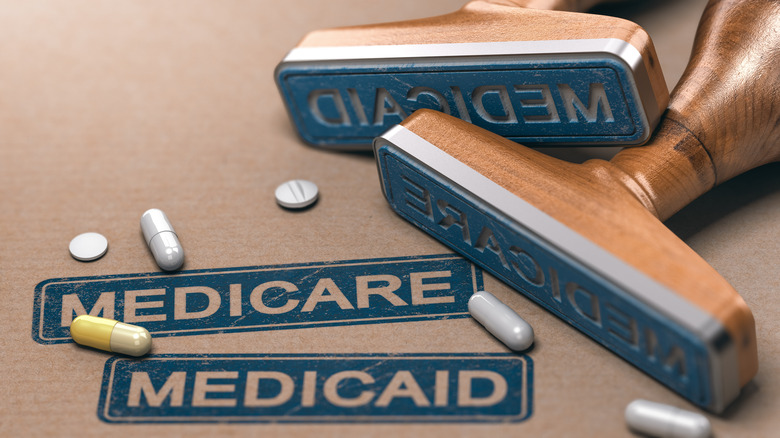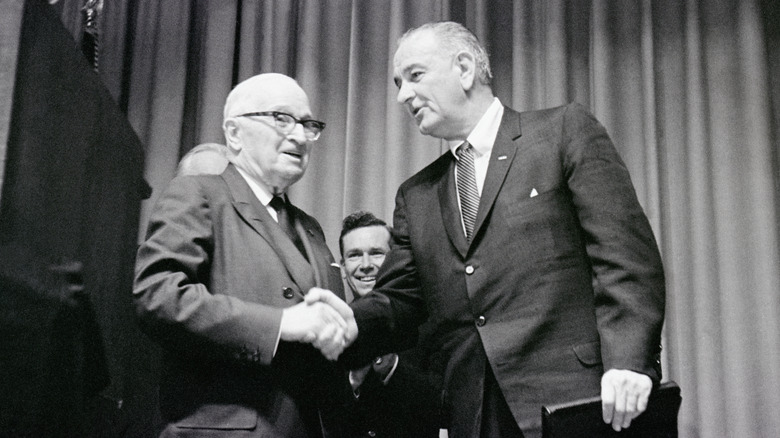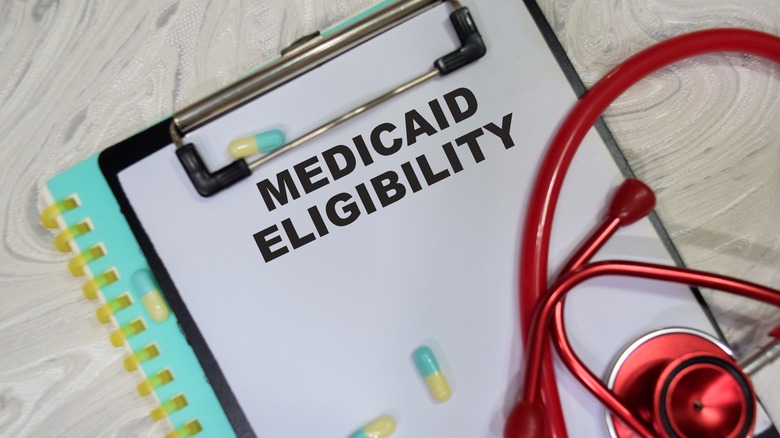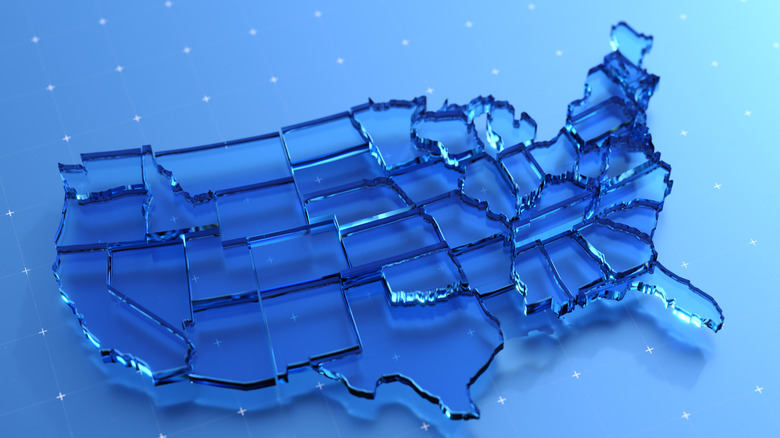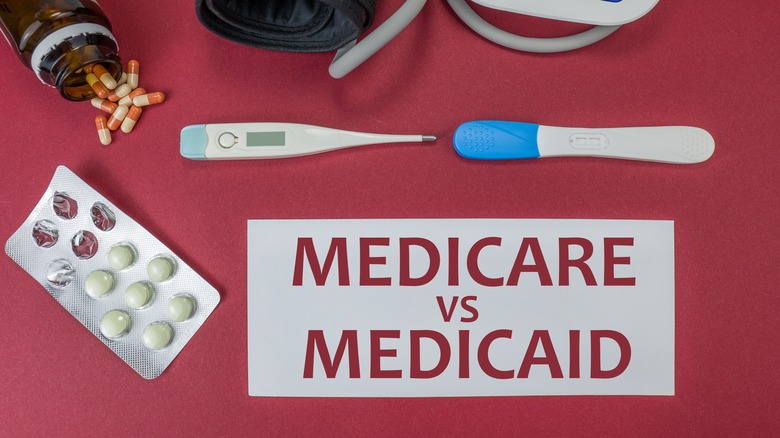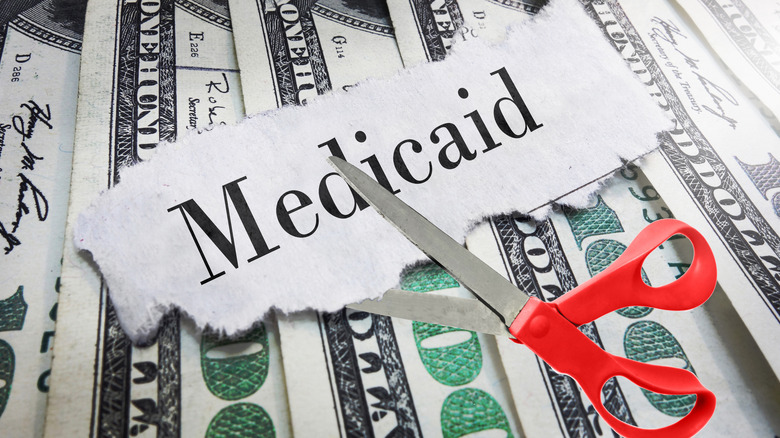The Key Differences Between Medicare And Medicaid
For many Americans, Medicaid and Medicare are the last line of defense against the rising cost of healthcare in the United States. According to the American Medical Association (AMA), health-related spending increased by 7.5% in 2023, to about $4.9 trillion. Americans are spending more money than ever on hospital care, physician services, and prescription medication. Medicaid and Medicare coverage have been essential for many U.S. citizens in covering their medical expenses. In 2024, Medicaid spending totaled nearly $909 billion; Medicare expenses during that same period are projected to have exceeded $1 trillion.
Medicaid and Medicare have both proven essential in bridging the wide gap in affordability for Americans who've struggled to keep up with healthcare expenses. Of the trillions of dollars that Americans spend annually meeting their medical needs, a remarkable portion of that money comes through patients using Medicaid, Medicare, or a combination of the two.
It is relatively easy to confuse the benefits of Medicaid and Medicare, as sometimes, these programs may be used to cover similar medical needs. Yet, due to crucial differences in how these programs work, as well as impending changes in federal and state laws regarding coverage and eligibility, it's more important than ever to have a clear understanding of these resources. In this article, we break down the key differences between Medicaid and Medicare.
Despite similarities in their names, Medicaid and Medicare function differently
Both Medicaid and Medicare were signed into law by President Lyndon B. Johnson under the Social Security Act of 1965. Each program exists due to a fundamental understanding that Americans often need financial assistance to access sufficient medical treatment and care. Although both Medicare and Medicaid were established under the same law, and each is associated with covering medical expenses, they tend to function somewhat differently.
Medicare should be considered a form of federal health insurance provided by the U.S. government. Some individuals choose coverage under "original Medicare," selecting either Part A (hospital insurance) or Part B (medical insurance) at predetermined times of the year. You may also choose a Plan C version, known as "Medicare Advantage," which is offered through a private company. This type of plan sometimes includes a Plan D, which covers drug prescriptions. Traditionally, Medicare is aimed at those 65 years and older, but due to eligibility changes, younger Americans can qualify for coverage.
The Medicaid program, like Medicare, is meant to cover medical expenses. However, it doesn't function as insurance. It is, instead, a joint effort by federal and state governments to provide medical and related assistance to low-income Americans. Medicaid was designed to help Americans in a broader range of ways than Medicare. While Medicare is usually accessed by and associated with much older Americans, Medicaid was created to assist a broader range of people, regardless of their age, income, and medical history.
There are noteworthy differences in eligibility
The nature of eligibility, ranging from financial to age requirements, can vary from state to state. In most cases, Medicare should be viewed as a program primarily aimed at low-income Americans, designed to help the most vulnerable citizens cover the cost of essential care, whether it be a trip to the emergency room or an annual eye exam.
Because Medicare is funded at the federal level, eligibility is relatively uniform across the country. Generally speaking, you must be at least 65 years old to qualify for coverage. There are a couple of notable exceptions, such as a severe disability, in which cases, you are encouraged to contact the Social Security Administration for additional information. If you or your spouse paid out Medicare taxes for at least 10 years, you are likely eligible for premium-free Part A Medicare. If you're unsure of your eligibility status or your next available enrollment period, you can find out by answering a few questions on the official Medicare website.
With Medicaid, program qualification is typically reserved for American citizens, with eligibility standards often varying from state to state. For instance, in Texas, a monthly income of $1,735 or less is required to qualify; for Californians, this income is insufficient to qualify without other factors, such as disability, pregnancy, or pre-existing support through state programs. You'll need to research the eligibility requirements to ensure you're eligible to sign up for Medicaid. This is especially important for anyone who has relocated to a new state, as you may find that your benefits have grown substantially or been significantly reduced.
Practicioners are more likely to use loopholes to reject Medicaid patients
For Americans who rely on Medicaid and Medicare, it's of the utmost importance to understand how and where these resources may be used for medical coverage. Research shows that upward of 17% of doctors report no revenue earned from Medicaid; 38% of doctors reported low-income revenue through this resource. Despite the worry expressed by low-income patients and legislative attempts made by state and federal policymakers, it remains an unfortunate fact that a significant portion of medical professionals refuse to serve Medicaid patients. And without adequate legal protections that prevent this form of discriminatory practices, Medicaid patients remain vulnerable to decreased access to care as they're likely to be deliberately shut out of treatment by a significant portion of private medical practitioners.
This isn't quite the case for Medicare, likely due to it being a purely federal form of medical coverage. Most doctors and hospitals accept Medicare; however, according to the program's official website, it is best to check with the provider to confirm acceptance of payment. Should the provider take Medicare, they may "charge you only the Medicare deductible and coinsurance amount," and wait until after Medicare covers most of the bill before reaching out to ask you to cover the remainder.
Though not uniformly accepted, it's crucial to note that Medicaid does, in fact, cover a greater range of medical needs than Medicare, and for a wider range of individuals. There may be legal loopholes that have yet to be closed, which may make it easier for some medical professionals to avoid paying Medicaid than they do with Medicare payments.
Medicare has one name, but Medicaid has many
New Yorkers call it Medicaid, but if you live in California, it's known as Medi-Cal. One of the more notable differences between Medicare and Medicaid is in how Americans actually refer to them. Medicare is uniformly known across the country by one name. This isn't the case for Medicaid, as many states choose to identify coverage by something other than the name put forward by the federal government. The reason for this decision may vary, and there are differing theories for how it came to be.
AARP suggests that the reason some states choose to call Medicaid something else is to help distinguish their program from that offered in another U.S. state. This could make sense, as a California recipient of Medicaid may have access to additional benefits under that program than are available in other locations; calling it Medi-Cal will help Californians know for sure what type of support they will get in their home state. Another plausible theory put forth by AARP is that the name change is intended to address the stigma surrounding the use of Medicaid. Research suggests that some Americans who rely on Medicaid fear "being treated poorly in the health care setting." Having to rely on government assistance for essential medical care may deter some citizens from signing up for Medicaid.
Despite the intent, some Americans may be unaware they actually have Medicaid due to confusion over the name change.
Medicaid lets states add optional benefits to coverage
As stated on the official Medicaid website, the service comes with a series of "mandatory benefits," that is, things that are automatically covered through this program. These items include "inpatient and outpatient hospital services, physician services, laboratory and x-ray services, and home health services," and more. A key difference between Medicaid and Medicare is that the latter doesn't have an equivalent list of required benefits. The Social Security Administration instead mentions that mandatory Medicare coverage is in effect for federal or state employees hired after March 31, 1986. Medicare likely falls under legal protections guaranteed by the federal government, so there's no need to distinguish between what's automatically covered and what isn't.
This isn't the case for Medicaid, as its coverage is a joint effort between the U.S. government and individual states. Any benefits that fall under federal coverage must be provided. However, Medicaid includes optional benefits, which allow states to decide what additional benefits they will cover. These might include "prescription drugs, case management, and physical therapy." Depending on your location, you may find that you have access to a greater range of medical treatment than you would if you lived in a different state.
Medicare tends to have more out-of-pocket expenses
As of 2025, the average monthly Medicare Part B premium payment is $185.00. While you likely do not have to pay premiums through Medicaid, there may be co-pays for which you are responsible. Unlike co-pays for Medicare, what's owed through Medicaid is often significantly lower; some estimates suggest payments range between $5 and $74. Out-of-pocket expenses for Medicaid are typically much lower than those for Medicare. The reason is likely due to Medicaid being set up to support the medical costs of lower-income Americans. Therefore, there is less expectation that they will be able to afford expensive monthly payments. Medicare, meanwhile, is primarily aimed at Americans of a certain age rather than a particular income level.
You may still have to come out of pocket for Medicaid, depending on your state. Even if that's the case, it may not be as much as Medicare premiums and co-pays. With this in mind, it's understandable why some Americans push to qualify for both Medicaid and Medicare.
Employment history plays greater role in Medicare coverage
It's important to note that a lack of employment does not automatically disqualify you from receiving either Medicaid or Medicare in the United States. You can technically be without a job and still potentially be eligible to claim benefits from either Medicaid or Medicare. The nature of how that works, however, will differ by program. For example, if you are a stay-at-home wife whose spouse paid out Medicare taxes for at least 10 years, you will still qualify for premium-free Part A Medicare. As most Americans collecting Medicare are 65 or older, these individuals are typically retired or preparing to exit the workforce, so there is no presumed pressure to remain employed while taking advantage of Medicare coverage.
This is not universally the case with Medicaid. Two states, Arkansas and Georgia, have work requirements that may impact Medicaid availability; the number of states where employment may be necessary to qualify for or maintain Medicaid coverage is expected to grow under the Trump Administration. Some concerns are that adding employment-related requirements for Medicaid access will result in many vulnerable low-income individuals and families losing coverage.
The government has different funding resources for Medicaid and Medicare
Although the U.S. government pays for Medicaid and Medicare, the funding does not originate from the same resources. The way the state and federal governments allocate funding for these programs is noteworthy for the significant differences in the funding process. For example, while many Americans are familiar with Medicare, they may not be aware that its money originates from the Medicare Trust Fund.
The Medicare Trust Fund is actually a combination of the Medicare Hospital Insurance Trust Fund (HI) and the Supplemental Medical Insurance Trust Fund (SMI). Americans contribute directly to the HI through income taxes paid into Social Security benefits and their payroll taxes. The SMI, meanwhile, is paid into through a combination of general revenue and the premiums that Medicare enrollees pay through their Part B coverage. While SMI funding is seen as a somewhat stable source for Medicare, there are ongoing concerns that the HI may face deficits in the future.
With Medicaid, there is a split in payment between federal and state coverage. Although the U.S. government reportedly accounts for 69% of Medicaid financing, the actual financial burden varies by state. California, for instance, is wealthy enough to split Medicaid coverage evenly, paying 50% of the funds. On the opposite end, Mississippi was only able to pay out 23%, leaving federal resources to make up the remaining 77%.
Medicaid offers greater potential to address food security
An often underappreciated aspect of poor health is its indirect relationship with food insecurity. According to the Center for Health Strategies, "food insecurity is a leading contributor to illness, death, health inequity, and health care costs." While Medicaid and Medicare can be used in specific instances to address food insecurity, Medicaid is the much more flexible option for affected Americans. Many states actively coordinate Medicaid coverage with food benefits through WIC and SNAP; they also provide food insecurity screenings and referrals to Medicaid recipients. Although food resources are not uniformly available across the United States, there appear to be greater opportunities for Americans in need to obtain groceries through Medicaid than through Medicare.
Obtaining food through Medicare appears to be a more challenging prospect than through Medicaid. To start, Medicare Part A and B do not have any provisions for accessing food. There is a limited grocery allowance under Part C or Medicare Advantage. Even so, eligibility is limited to those suffering from severe health issues related to cancer, heart failure, end-stage liver or kidney disease, dementia, or HIV. It's worth noting that American seniors, who make up the bulk of Medicare recipients by some margin, can experience food security issues. According to Feeding America, over seven million seniors experienced food insecurity in 2022. Until changes are made to how Medicare could be used to access groceries, Americans who need food assistance are more likely to get support through Medicaid resources.
Medicare may be more vulnerable to Big Bill cuts
Following the passage of the Trump Administration's 2025 budget reconciliation bill, also known as the "Big Beautiful Bill," the government plans to significantly reduce healthcare-related spending over the next decade. There are concerns about the immediate and long-term impact of the bill on both Medicaid and Medicare. Based on estimates from the Congressional Budget Office, Medicaid is projected to lose $911 billion in funds over the next decade; it's also anticipated that the number of uninsured Americans will increase by 10 million by 2034. Just as worrying, with federal spending declining so sharply, researchers believe that states will move to cut their own spending, as many will not be able to make up the deficit caused by a drop in Medicaid funding.
As for Medicare, the "Big Bill" will reportedly cut Medicare funding by $500 billion. While the funding cuts are problematic in and of themselves, it seems that much of the impact on Medicare recipients may be indirect, caused by legislative changes, rather than directly out of pocket. Specific provisions under the "Big Bill" attempt to eliminate national nursing home standards that previously protected Medicare patients. Additionally, the bill will prevent Medicare from effectively negotiating the cost of expensive drug prescriptions.
While both Medicaid and Medicare cuts will impact millions of Americans and non-citizens, it's possible that the impact on Medicare recipients will be greater because there will be no state spending or local legislation to offer coverage or legal protection to offset the negative effects of the "Big Bill." Some states may make adjustments to local Medicaid that mitigate the harm caused by spending cuts. As the United States government is entirely responsible for funding Medicare, no such mitigation is possible, regardless of where you live.
